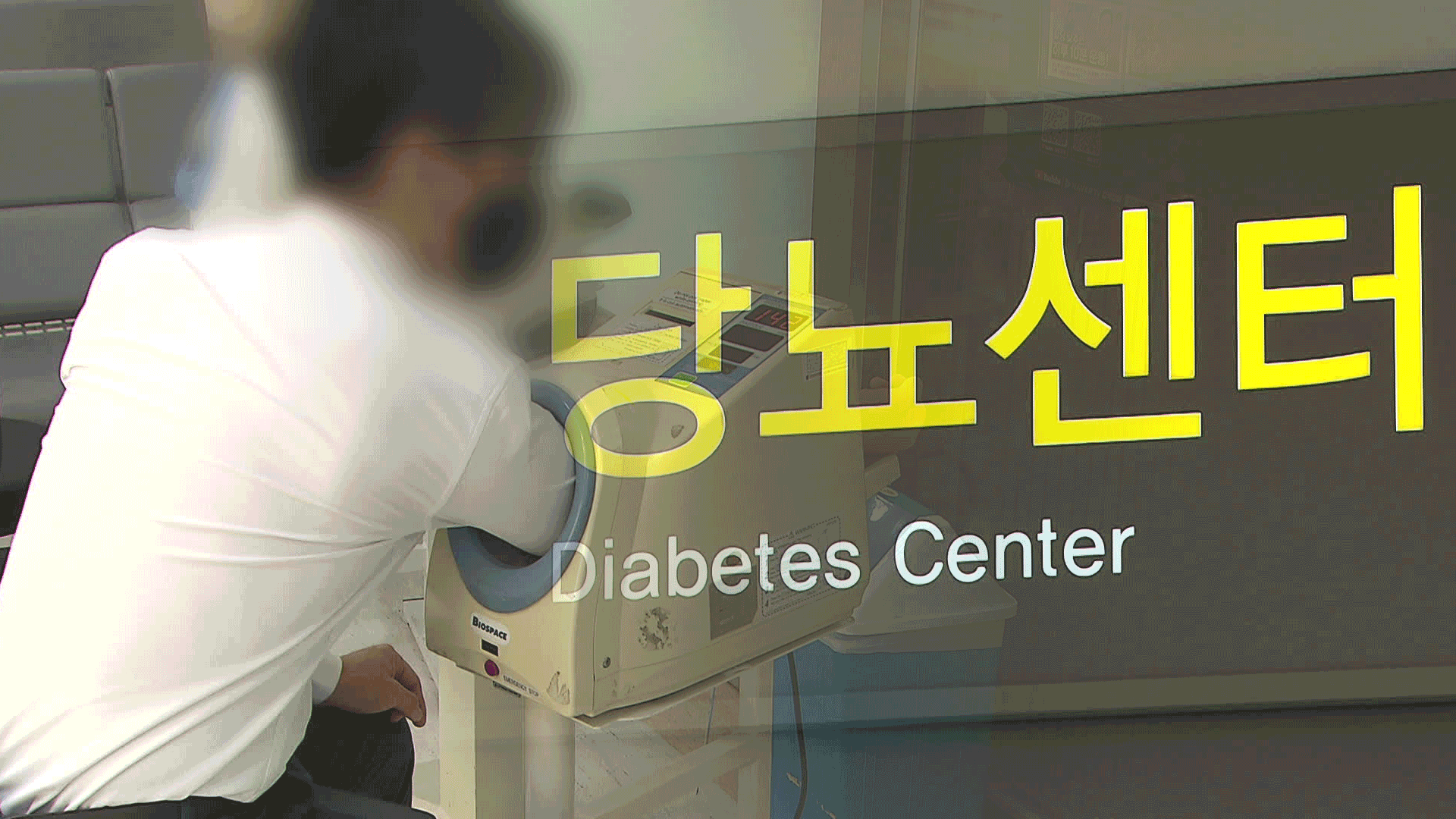[Anchor]
The number of young diabetes patients in their teens and twenties is increasing.
It has surged nearly fourfold in the past decade.
Obesity has been cited as a major cause, and the incidence rate is higher among those with lower incomes.
Reporter Jin Sun-min has the details.
[Report]
This man, who has been severely obese since high school, was diagnosed with diabetes eight years ago when he turned 20.
After more than five years of strict diet management and exercise, he has returned to a normal weight, but he still needs to manage his blood sugar levels.
[Kim Seung-hwan/Diabetes Patient: "Since I lost weight, my diabetes levels have definitely dropped a lot. Not only that, I also feel less short of breath..."]
Diabetes was originally common among middle-aged and older adults, but recently, the number of young patients has sharply increased.
An analysis of health insurance claims data from 130,000 diabetes patients revealed that the prevalence among those under 30 rose from 73 per 100,000 people in 2008 to 270 in 2021, nearly quadrupling in 13 years.
This trend is closely related to the eating habits of teenagers and young adults.
The obesity rate among children and adolescents increased from 9% in 2012 to 19% in 2021.
In particular, low-income individuals receiving medical assistance are increasingly vulnerable to diabetes.
They are 3.7 times more likely to develop diabetes compared to middle- and high-income groups, and children are 5.1 times more likely, widening the gap.
[Kim Jae-hyun/Professor of Pediatrics at Bundang Seoul National University Hospital: "Eating habits focused on high-calorie, low-nutrition foods and the likelihood of poor surrounding environments can lead to obesity and an increase in type 2 diabetes..."]
Once diabetes occurs, it is difficult to cure, and lifelong management through diet control and exercise is necessary.
As the number of young diabetes patients increases, the socio-economic losses also grow, prompting experts to call for national-level management.
This is KBS News, Jin Sun-min.
The number of young diabetes patients in their teens and twenties is increasing.
It has surged nearly fourfold in the past decade.
Obesity has been cited as a major cause, and the incidence rate is higher among those with lower incomes.
Reporter Jin Sun-min has the details.
[Report]
This man, who has been severely obese since high school, was diagnosed with diabetes eight years ago when he turned 20.
After more than five years of strict diet management and exercise, he has returned to a normal weight, but he still needs to manage his blood sugar levels.
[Kim Seung-hwan/Diabetes Patient: "Since I lost weight, my diabetes levels have definitely dropped a lot. Not only that, I also feel less short of breath..."]
Diabetes was originally common among middle-aged and older adults, but recently, the number of young patients has sharply increased.
An analysis of health insurance claims data from 130,000 diabetes patients revealed that the prevalence among those under 30 rose from 73 per 100,000 people in 2008 to 270 in 2021, nearly quadrupling in 13 years.
This trend is closely related to the eating habits of teenagers and young adults.
The obesity rate among children and adolescents increased from 9% in 2012 to 19% in 2021.
In particular, low-income individuals receiving medical assistance are increasingly vulnerable to diabetes.
They are 3.7 times more likely to develop diabetes compared to middle- and high-income groups, and children are 5.1 times more likely, widening the gap.
[Kim Jae-hyun/Professor of Pediatrics at Bundang Seoul National University Hospital: "Eating habits focused on high-calorie, low-nutrition foods and the likelihood of poor surrounding environments can lead to obesity and an increase in type 2 diabetes..."]
Once diabetes occurs, it is difficult to cure, and lifelong management through diet control and exercise is necessary.
As the number of young diabetes patients increases, the socio-economic losses also grow, prompting experts to call for national-level management.
This is KBS News, Jin Sun-min.
■ 제보하기
▷ 카카오톡 : 'KBS제보' 검색, 채널 추가
▷ 전화 : 02-781-1234, 4444
▷ 이메일 : kbs1234@kbs.co.kr
▷ 유튜브, 네이버, 카카오에서도 KBS뉴스를 구독해주세요!
- Young diabetes up 4x in 13 years
-
- 입력 2025-08-27 01:38:24

[Anchor]
The number of young diabetes patients in their teens and twenties is increasing.
It has surged nearly fourfold in the past decade.
Obesity has been cited as a major cause, and the incidence rate is higher among those with lower incomes.
Reporter Jin Sun-min has the details.
[Report]
This man, who has been severely obese since high school, was diagnosed with diabetes eight years ago when he turned 20.
After more than five years of strict diet management and exercise, he has returned to a normal weight, but he still needs to manage his blood sugar levels.
[Kim Seung-hwan/Diabetes Patient: "Since I lost weight, my diabetes levels have definitely dropped a lot. Not only that, I also feel less short of breath..."]
Diabetes was originally common among middle-aged and older adults, but recently, the number of young patients has sharply increased.
An analysis of health insurance claims data from 130,000 diabetes patients revealed that the prevalence among those under 30 rose from 73 per 100,000 people in 2008 to 270 in 2021, nearly quadrupling in 13 years.
This trend is closely related to the eating habits of teenagers and young adults.
The obesity rate among children and adolescents increased from 9% in 2012 to 19% in 2021.
In particular, low-income individuals receiving medical assistance are increasingly vulnerable to diabetes.
They are 3.7 times more likely to develop diabetes compared to middle- and high-income groups, and children are 5.1 times more likely, widening the gap.
[Kim Jae-hyun/Professor of Pediatrics at Bundang Seoul National University Hospital: "Eating habits focused on high-calorie, low-nutrition foods and the likelihood of poor surrounding environments can lead to obesity and an increase in type 2 diabetes..."]
Once diabetes occurs, it is difficult to cure, and lifelong management through diet control and exercise is necessary.
As the number of young diabetes patients increases, the socio-economic losses also grow, prompting experts to call for national-level management.
This is KBS News, Jin Sun-min.
The number of young diabetes patients in their teens and twenties is increasing.
It has surged nearly fourfold in the past decade.
Obesity has been cited as a major cause, and the incidence rate is higher among those with lower incomes.
Reporter Jin Sun-min has the details.
[Report]
This man, who has been severely obese since high school, was diagnosed with diabetes eight years ago when he turned 20.
After more than five years of strict diet management and exercise, he has returned to a normal weight, but he still needs to manage his blood sugar levels.
[Kim Seung-hwan/Diabetes Patient: "Since I lost weight, my diabetes levels have definitely dropped a lot. Not only that, I also feel less short of breath..."]
Diabetes was originally common among middle-aged and older adults, but recently, the number of young patients has sharply increased.
An analysis of health insurance claims data from 130,000 diabetes patients revealed that the prevalence among those under 30 rose from 73 per 100,000 people in 2008 to 270 in 2021, nearly quadrupling in 13 years.
This trend is closely related to the eating habits of teenagers and young adults.
The obesity rate among children and adolescents increased from 9% in 2012 to 19% in 2021.
In particular, low-income individuals receiving medical assistance are increasingly vulnerable to diabetes.
They are 3.7 times more likely to develop diabetes compared to middle- and high-income groups, and children are 5.1 times more likely, widening the gap.
[Kim Jae-hyun/Professor of Pediatrics at Bundang Seoul National University Hospital: "Eating habits focused on high-calorie, low-nutrition foods and the likelihood of poor surrounding environments can lead to obesity and an increase in type 2 diabetes..."]
Once diabetes occurs, it is difficult to cure, and lifelong management through diet control and exercise is necessary.
As the number of young diabetes patients increases, the socio-economic losses also grow, prompting experts to call for national-level management.
This is KBS News, Jin Sun-min.
-
-

진선민 기자 jsm@kbs.co.kr
진선민 기자의 기사 모음
-
이 기사가 좋으셨다면
-
좋아요
0
-
응원해요
0
-
후속 원해요
0















이 기사에 대한 의견을 남겨주세요.